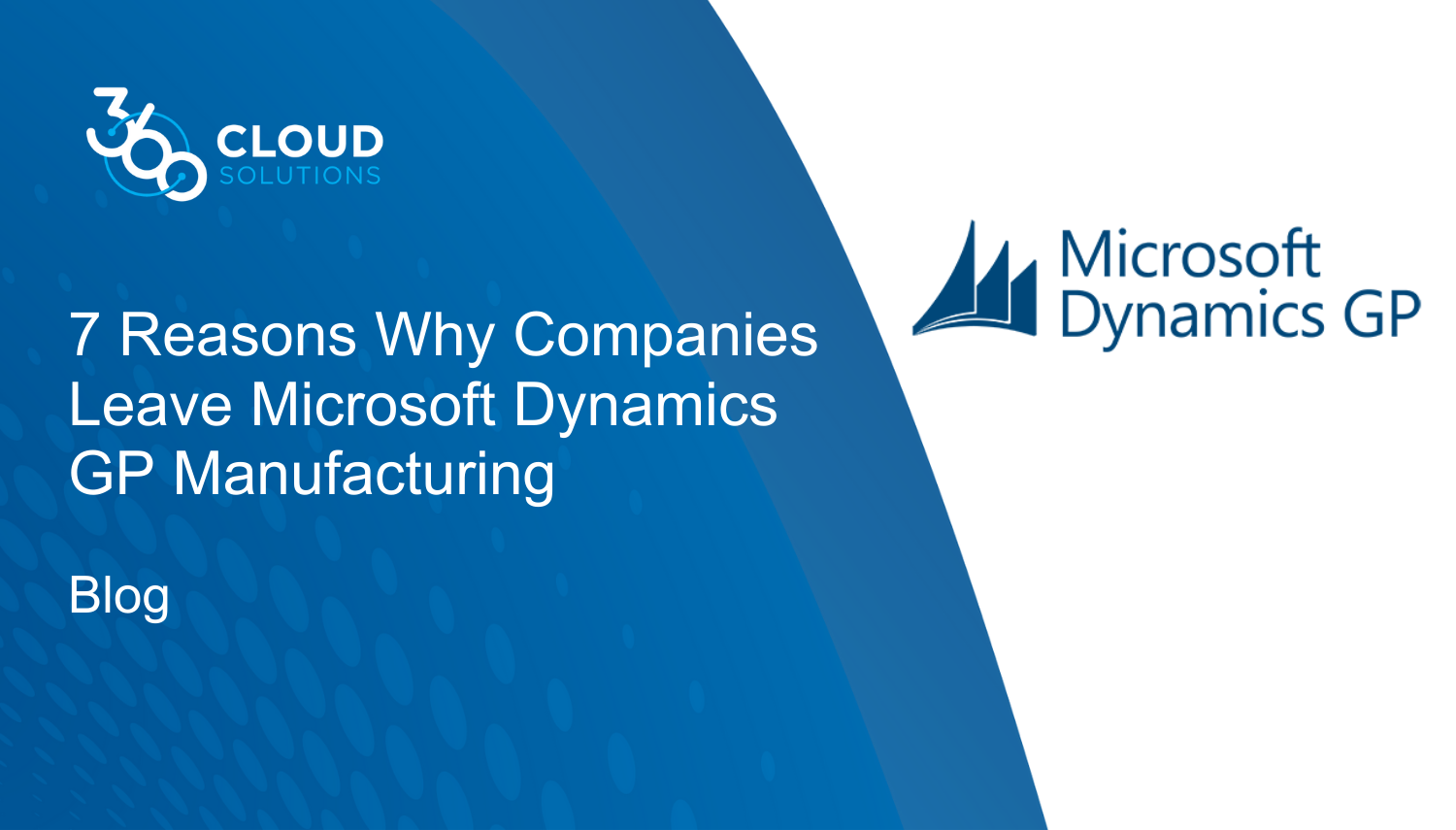
Microsoft Dynamics GP (Great Plains) Manufacturing is one of the most widely-recognized financial management software applications, serving as the flagship product for their Microsoft Dynamics Package.
While it has tremendous functionality, it also has significant limitations. Because of the trusted name and a familiar user interface, the Microsoft Dynamics GP platform may blind potential customers to the application behind the scenes issues. Here are ten reasons why Microsoft’s customers are leaving Dynamics GP Manufacturing in search of a better solution:
1. DIY Management
Microsoft Dynamics GP requires that the customer manage the hardware, servers, and databases, in addition to upgrading, troubleshooting, and maintaining the applications—unless, of course, you want to pay a third party even more money to try managing it for you. You will have to spend the time and internal resources to accomplish an upgrade or hire an external contractor once a year or more to do it if you want to keep your software current.
Customers who switched to another ERP platform confirmed they were required to manage the hardware, servers, and databases. They were also required to troubleshoot and maintain the applications.
2. No Native CRM System
GP covers many functional areas, but it has no built-in CRM system. You have to buy and integrate two different Microsoft products or a third-party solution like Salesforce to get CRM support. The problem is, whether it’s Salesforce or even Microsoft’s products, they have different code sets, and they have trouble integrating with Dynamics GP Manufacturing.
Purchasing a solution that does not contain a native CRM system will add to the total cost of the purchase.
3. Dynamics GP Manufacturing is Surprisingly Expensive to Purchase
Microsoft Dynamics GP can prove an expensive and time-consuming business solution—both long and short term. With Microsoft Dynamics GP, customers pay hefty fees upfront for the software and implementation. But the costs don’t end there. Many customers who have switched from Microsoft Dynamics GP tell us that the escalating costs and complexity of running their business software environment using Microsoft Dynamics GP was a key reason for their defection.
The full-suite can cost between $20,000-$250,000, and Microsoft charges approximately $3,500 per concurrent user, and implementation can be 1-1.5 times the purchase price. Then, support adds a required yearly maintenance fee of 15-20% for only a few calls. Customers have to pay a premium for the “privilege” of unlimited support calls.
Suppose you’re thinking of paying more to run Microsoft Dynamics GP delivered as a hosted solution. In that case, you need to know how a specific Microsoft VARs proprietary add-on hosting service compares with NetSuite’s data center and web-native SaaS application.
Compare and contrast this with NetSuite, in which you get a data center that has rigorous financial and security certifications, including SAS 70 Type II, PCI DSS, and EU-Safe Harbor compliance. You get uptime guarantees with a 99.5% Service Level Commitment and availability transparency published at status.netsuite.com. You get an application that’s upgraded twice a year—automatically. And you get a solution that’s designed for the web and is 100% browser-based, so you can securely access it from anywhere.
4. Dynamics GP Manufacturing is Difficult To Integrate
In most cases, Microsoft Dynamics GP forces companies to manage their business with separate on-premise systems for accounting, sales, e-commerce, service, and, frequently, warehousing. In such environments, the cost of implementation, integration, and ongoing maintenance can be many times more than the software itself. Often, information is manually re-entered or batched into other applications, and organizations have to manage the business on incomplete information and guesswork.
The cost of implementation, integration and ongoing application maintenance in such environments can be many times the price of the software itself. Moreover, patching together products can result in multiple data islands and expensive integration projects that often don’t work the way you want.
Many customers tell us that with Microsoft Dynamics GP, information often must be manually re-entered or batched into other applications—costing time and money. You can end up managing your business on incomplete information and guesswork.
In contrast, NetSuite integrates ERP, accounting, customer relationship management (CRM), and e-commerce capabilities in a single on-demand application, with editions tailored for specific industries. As a result, it allows companies to unite fragmented data and automate processes from end to end. Your employees no longer have to re-enter data in different systems, rectify inconsistent or inaccurate data, or wait for batch updates.
5. No Real-Time Results
With the deployment of disparate systems in conjunction with Microsoft Dynamics GP, your business data is often spread across multiple departments, resulting in a lack of real-time visibility across critical metrics needed to optimize business operations. It slows down reporting and decision-making, along with an increased likelihood of error.
In contrast, NetSuite holds all corporate data in a single database, giving you access to your key performance metrics on a customizable, real-time dashboard. Employees can view and share accurate data in real-time, leading to greater collaboration among departments and increased productivity across your business. In addition, complete visibility into unified customer records results in more efficient and highly personalized sales, fulfillment, and service processes.
6. No Support for Revenue Recognition
Companies required to adhere to GAAP-compliant revenue recognition have to integrate a third-party product. Dynamics GP Manufacturing doesn’t support planning or phase-based timing of revenue recognition.
Microsoft Dynamics GP can consolidate multinational financial information for month-end reporting if you run separate Great Plains accounts and use external reporting tools, but that’s about it.
In contrast, NetSuite OneWorld is the first and only on-demand system to deliver real-time global business management, financial consolidation, and visibility to multinational, multi-subsidiary companies.
7. Customization is Dangerous
Because everybody (you, NetSuite, development partners) all play on the same platform, leveraging the same database, upgrades happen seamlessly. No longer is customization a lousy word.
Customers say that one change to the code can impact the entire ERP system. Therefore, developers must write customizations outside of the application itself and re-integrate them back to the native application.
A Microsoft Dynamics GP implementation can cost one to one-and-half times the purchase price of the software itself or even more. Microsoft Dynamics GP can become hard to upgrade when dealing with customizations specific to your business and integrations with other solutions, such as sales force management and e-commerce. Add to that the resources required to maintain it.
NetSuite’s development platform includes a layer of user-driven, point-and-click configuration tools that enable users/admin to add/remove fields, change field names and build workflows—for example, automated, sales approvals, or multi-step collections process. Barring the cost of hiring developers, this reduces time-to-change and empowers an organization through increased control.
Bonus Guide: Microsoft Dynamics vs. NetSuite [Comparison Chart]
Enterprise resource planning (ERP) software for mid-sized companies comes in many different types. Many executives are looking for a simple comparison guide to see the vast differences between Microsoft Dynamics vs NetSuite.
Manufacturing & Distribution Management
| Microsoft Dynamics | NetSuite |
|
|
Complex Business Processes
| Microsoft Dynamics | NetSuite |
|
|
Functionalities
| Microsoft Dynamics | NetSuite |
|
|
Cloud/On-Premises
| Microsoft Dynamics | NetSuite |
|
|
There is no reason to settle for a mediocre solution and implement a modern solution with a wide range of customization capabilities to fit your every business need.
For more on Microsoft Dynamics and how companies are making the switch to NetSuite, download the guide: “IT Executives Express Need for True Cloud ERP,” a deep exploration into why senior IT executives made the switch from Microsoft to NetSuite, and what happened in this process.




